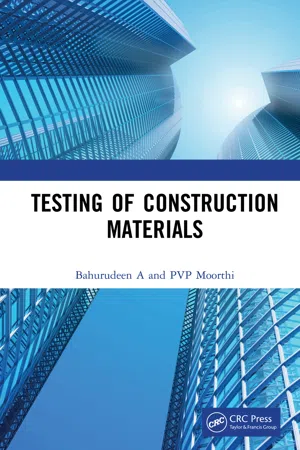
Testing of Construction Materials
Bahurudeen A, P.V.P. Moorthi
- 450 pages
- English
- ePUB (mobile friendly)
- Available on iOS & Android
Testing of Construction Materials
Bahurudeen A, P.V.P. Moorthi
About This Book
This book provides an understanding of peer-reviewed international construction materials and their testing methods in a simplified manner at a high technical level. It focuses on specific construction materials, such as cement, concrete, bricks, lime, paints, steel and so forth, distributed in ten different chapters. Using real-time quality control as the underlying determinant, the book material exclusively follows Indian, American, European, German and South African standards. Relevant modern sophisticated material testing techniques, like scanning electron microscope (SEM), thermo gravimetric analysis (TGA) and X-Ray diffraction (XRD), are also described. Aimed at undergraduate, senior undergraduate and early career professionals in civil engineering and construction engineering, this book
-
- Gives a clear background of material testing and its importance
-
- Includes step-by-step procedures for easy understanding of and for performing the tests
-
- Covers Indian, ASTM, South African, DIN German and European Standards
-
- Includes basic and advanced techniques for chemical admixtures
-
- Each chapter concludes with practice questions, including 400+ solved questions and 50+ test procedures in total